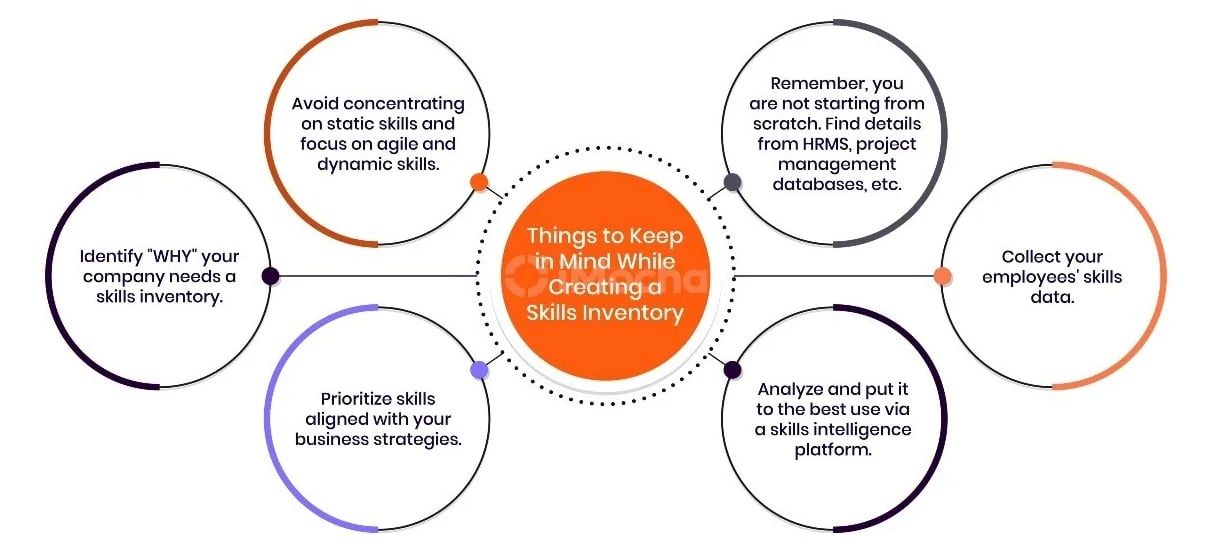A skills inventory is a compilation of work-based and educational information of your employees that can help you and your company:
- Make progress on your corporate strategy
- Equip workforce to adapt to changes
- Enhance workforce performance
- Help attain business goals
- Operate business efficiently
What is Skills Inventory?
Skills inventory is a comprehensive and dynamic list of your employees’ work experiences, educational qualifications, licenses, certifications, and other job-relevant details. Regardless of the business sector you are in, it is integral to have a centralized skills inventory for your company to future-proof it from any form of disruptions.
However, many organizations don’t pursue this pathway. 
Components of Skills Inventory
According to a Gartner report (Published in December 2021), only 38% of IT companies create a skills and competencies inventory annually. Due to this, they fail to identify skills gaps and confront issues while executing their digital strategies.
There is no crystal ball yet that can help outline all the relevant skills to aid your business in the coming years. But having an updated skills inventory in your organization can offer some relief as it:
- Facilitates the business blueprint
- Helps you adapt to changing business demands and skills required
- And allows you to invest in developing and nurturing skills that can benefit your company in the long run
Its relevance enhances further, considering that the “half-life of skills” is decreasing drastically, and the total number of skills required to perform a single job is increasing by 6.3% yearly. As a result, several skills are becoming obsolete, and many others are evolving rapidly.
Considering all these factors, your organization can benefit greatly when it has a repository of skills. By doing so, your company can create a pathway for achieving strong skills intelligence, bolstering your talent acquisition and development activities. Remember that a skills inventory with up-to-date skills data of your employees is a key point in attaining skills intelligence.
Besides, a skills inventory can also help your company better understand how to invest in your human capital, and provide numerous benefits in recruiting, learning and development, succession planning, strategic planning, business continuity planning, etc.
|
'Skills-First' Companies have achieved 2x higher revenue growth than their peers. Don't miss out! |
How can you create a Skills Inventory?
Before your company traverses the extra mile to create a skills inventory, it is essential to understand why your organization needs one.
So, take your time and ask why your company need a skills inventory. What will be its purpose?
To answer these queries, you must first work on your company’s objectives and ensure they align well with your business goals and requirements.
While creating a skills inventory for your company, ensure that you are not concentrating on static skills. Instead, it is best to align it with the ever-changing skills needs.

Things to keep in mind while creating a skills inventory
However, creating such an agile and dynamic skills inventory is no small feat.
Therefore, instead of turning over every stone, it can be in your best interest to prioritize skills and competencies that can enhance your company’s business strategies in the short-term and long term.
It indeed sounds a bit intriguing.
But, in reality, this isn’t that bad. In most cases, you won’t be starting from scratch. This is because your company already has a lot of information regarding its employees in the HRMS, talent reviews, portfolios, project management databases, etc.
And nowadays, you can rely upon artificial intelligence to create skills inventories, as traditional methods are time-consuming, expensive, and can get outdated in no time.
As a starting point, your company can begin with general skills and then move forward into the specifics while identifying the skills crucial for your organization. And these skills will vary based on your business type, industry and the growth plans for your company.
Anyway, collecting your employees’ skills data through different sources is essential, striving to avoid discrepancies and bring in consistency. It can be highly beneficial to rely on skills intelligence. It is because skills taxonomies present within it can facilitate you with the relevant terminologies and languages to bring forth consistency in skill names and descriptions.
Skills data of your employees can include self-assessment data, manager’s assessment, social data (including LinkedIn, GitHub), internal system data (including project history), and validated skills via skills assessments.

Different resources for collecting skills data for your skills inventory
In self-assessments and manager’s assessments, there can be subjective and/or objective approaches.
In a subjective approach, your employees or managers can mark the proficiencies at different levels (for instance, you can have it as beginner, intermediate, proficient). But accuracy can be a concern.
Coming to an objective approach, your employees or their managers must validate the skills mentioned with relevant project-based scenarios, focusing on how they have applied these skills fruitfully. Similarly, your company can further validate the skills by conducting assessments from which you can obtain measurable results and analytics.
Once your organization has collated your employees’ skills data, you can analyze it and measure their results with a systematic approach. Besides, you can make the best out of it and attain your business goals by seeking the assistance of skills intelligence.
What is the role played by Skills Inventory in achieving Skills Intelligence?
Skills inventory acts as a backbone for attaining skills intelligence. When you facilitate your up-to-date skills inventory, the skills intelligence platform will analyze it further by focusing on skills taxonomies and market intelligence.
Through this, you can identify whether or not your organization has the right skills to build a skills-first company.
If yes, you can find the details of employees with the required skill sets.
If not, you can discover if your employees have adjacent or overlapping skills and if there are opportunities for upskilling, reskilling, or cross-skilling. This information can be used to hire new employees too.
Once you have hired the employees, you can update their details on your skills inventory and continue the process.
Well, these are some instances of how skills inventory can help attain skills intelligence. But there are several other ways through which a skills inventory can help your company gain a competitive advantage.
Conclusion
To conclude, skills inventory significantly enhances your business on different levels, primarily when used with skills intelligence. It can assist in various funnels of human resource management, ranging from recruitment to employee retention. And these factors can help your company steer through challenging times as well as build a future focused skill-first workplace.


